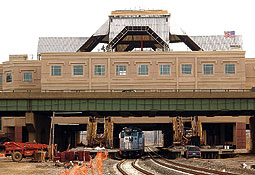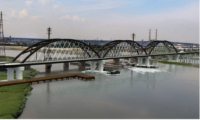 |
| TIED TOGETHER Secaucus terminal connects 11 New Jersey commuter lines at one point. |
For about 40 years, transit planners have dreamed of connecting Northern New Jerseys jumble of passenger rail lines at a single point, say New Jersey Transit officials. The dream now is reality. The $600-million Secaucus Transfer Station began operation Sept. 5.
The 312,000-sq-ft terminal in the swampy Meadowlands on Amtraks Northeast Corridor between New York City and Newark gives passengers single-point access to 10 of the states 11 commuter rail lines. The exception is a line from Philadelphia to Atlantic City. Many New York-bound commuters now will be able to connect directly to trains into New York Citys Penn Station, instead of transferring at Hoboken to PATH trains or ferries into Lower Manhattan.
"The geotechnical work was quite a challengebuilding extra tracks in the swamp on 10 ft of organics," says Rich Sirabian, project manager for transportation consulting engineer Edwards & Kelcey Inc. Shortly after funds were earmarked in 1989, New Jersey Transit tapped the Morristown, N.J.-based firm to head a team of 17 consultants.
 |
To support the terminal and an adjacent planned commercial-retail complex, contractors supercharged the soil 30 ft or higher in six lifts, placed hundreds of oversized caissons and drove H-piles to bedrock (ENR 1/20/97 p. 20.)
The owner broke the work into a dozen major contracts for a wide range of tasksaccess roads, electrical line relocation, foundation and superstructure work, roadwork and grade separation, station finish and interior bridges, signage, additional track work and turnout fabrication. Federal funds covered 75% of the cost, with the remainder coming from state and regional transportation authorities.
|
New York City-based architects Brennan Beer Gorman designed the terminal. It straddles Northeast Corridor and Bergen County-Main Line tracks in an L shape on three levels. The multi-level maze of a terminal building has 12 elevators, 31 escalators and 36 stairwells.
The 9/11 attacks delayed completion by several months. Wood Ridge, N.J.-based Terminal Construction Co. won the largest bid packagethe station finish and interior bridges. But it left $16 million on the table and struggled a bit. "We lost a lot of workers going into the city to work on the post-9/11 cleanup," says Donald N. Dinallo, Terminals president and owner. The decision to add a clock tower and other changes cost more time and pushed contract costs from $90 million to $119.5 million, he says.
Allied Junction Corp., a billboard company that bought the 28-acre site in the 1980s for $130,000, hopes someday to build a hotel and four 30 to 40-story office buildings above the terminal.
(Photos courtesy Of Edwards And Kelcey)



Post a comment to this article
Report Abusive Comment